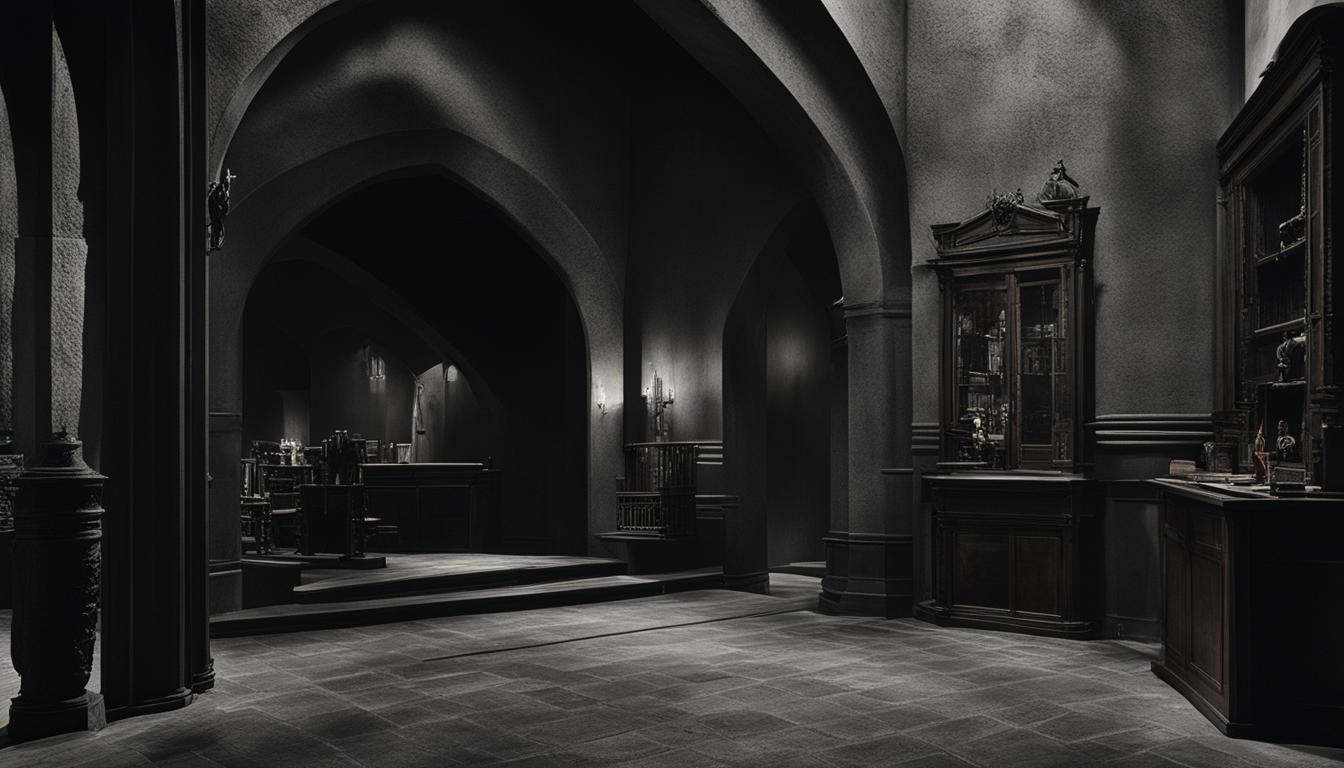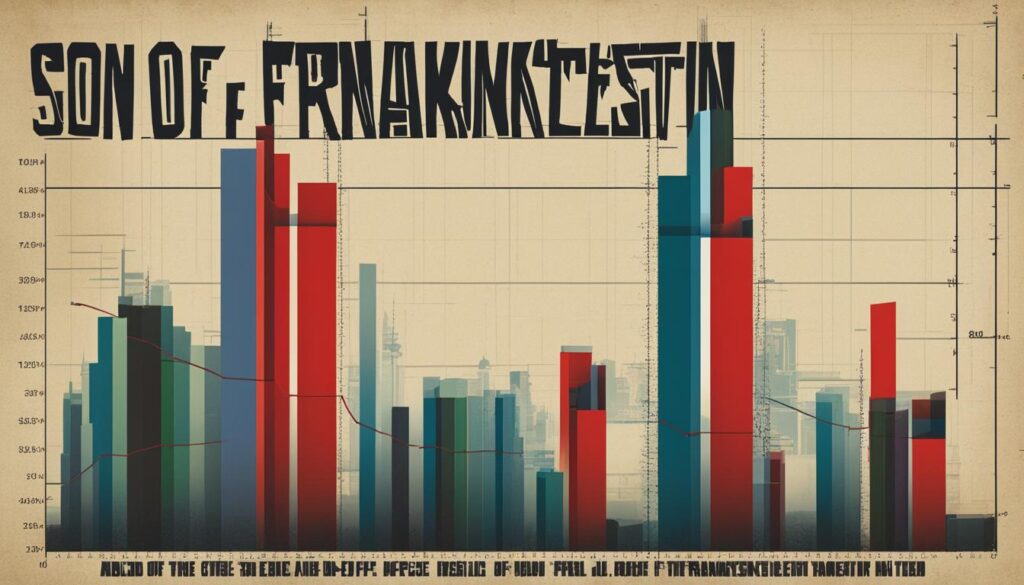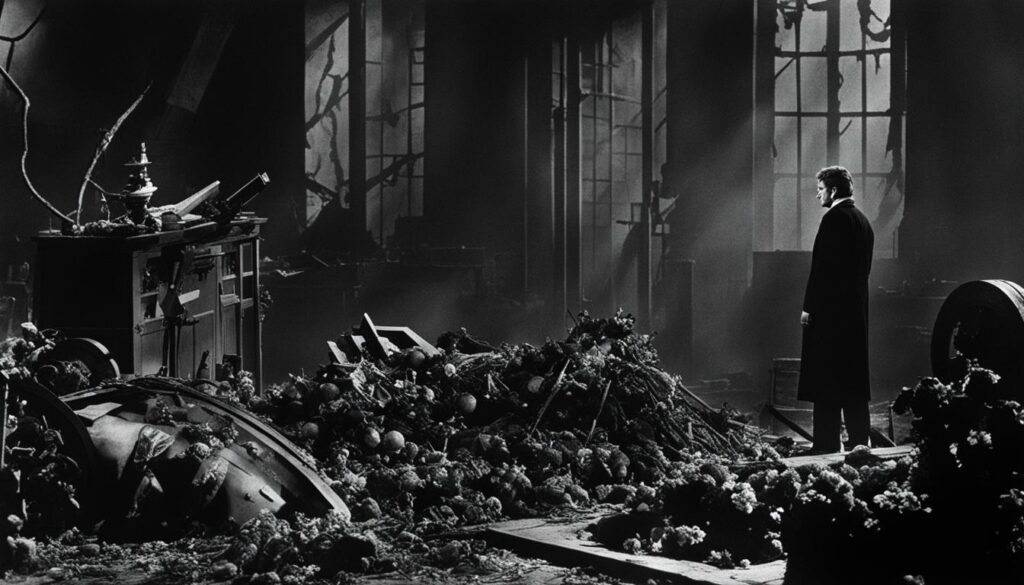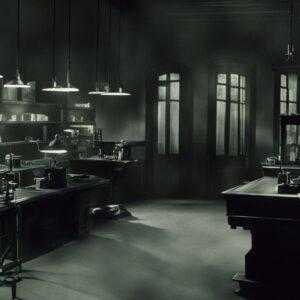Welcome to my article where we will explore the depths of the classic monster movie, “Son of Frankenstein (1939)”. This iconic horror film, produced by Universal Pictures, has captivated audiences for generations with its chilling tale and unforgettable characters. Starring Basil Rathbone, Boris Karloff, and Bela Lugosi, this film is a must-watch for any horror enthusiast or fan of the Frankenstein franchise. So, let’s journey into the heart of darkness and discover why “Son of Frankenstein (1939)” remains an enduring classic in the world of horror.
Key Takeaways:
- “Son of Frankenstein (1939)” is a classic monster movie that continues the iconic horror franchise.
- The film features an incredible cast, including Basil Rathbone, Boris Karloff, and Bela Lugosi.
- “Son of Frankenstein (1939)” explores themes of responsibility and the consequences of playing god.
- The film had a significant impact on the horror genre and the Frankenstein franchise, paving the way for future installments.
- For horror film fans, other films in the Frankenstein franchise, such as “Frankenstein” (1931) and “Bride of Frankenstein” (1935), are highly recommended.
The Plot of “Son of Frankenstein (1939)”
The plot of “Son of Frankenstein (1939)” centers around Dr. Wolf von Frankenstein, the son of the infamous Dr. Frankenstein. Returning to his family’s ancestral castle, Dr. Frankenstein discovers that his father’s creation, the monster, is still alive. As he delves deeper into the mysteries of his father’s experiments, Dr. Frankenstein becomes entangled in a dangerous world of reanimation and the consequences of playing God.
Driven by his desire to restore his family’s name and reputation, Dr. Frankenstein must confront the ethical implications of his father’s actions and the dangers that arise from meddling with life and death. With his loyal assistant, Ygor, by his side, Dr. Frankenstein embarks on a perilous journey filled with thrilling twists and turns.
As the plot unfolds, audiences are taken on a suspenseful and chilling ride, mirroring the dark and atmospheric tone of the film. The story raises thought-provoking questions about responsibility, morality, and the limits of scientific exploration, leaving viewers captivated until the very end.
Table: Characters in “Son of Frankenstein (1939)”
| Character | Actor |
|---|---|
| Dr. Wolf von Frankenstein | Basil Rathbone |
| The Monster | Boris Karloff |
| Ygor | Bela Lugosi |
“Son of Frankenstein (1939)” continues the legacy of the Frankenstein franchise, exploring the repercussions of the iconic mad scientist’s experiments and the enduring power of his creation. It is a gripping tale of science, morality, and the consequences of tampering with nature.
The Cast of “Son of Frankenstein (1939)”
One of the standout elements of “Son of Frankenstein (1939)” is its talented cast. Led by the renowned Basil Rathbone, who portrays Dr. Wolf von Frankenstein, the film features a stellar lineup of actors who bring the characters to life with their captivating performances. Boris Karloff reprises his role as the iconic monster, delivering a haunting portrayal that continues to resonate with audiences to this day. Bela Lugosi, known for his portrayal of Dracula, adds a layer of cunning and intrigue to the film as Ygor, a character who plays a significant role in the story’s development.
With Rathbone, Karloff, and Lugosi at the helm, “Son of Frankenstein (1939)” is a masterclass in acting. Each actor brings their unique style and presence to their respective roles, creating a dynamic ensemble that enhances the film’s overall impact. Rathbone’s commanding performance as Dr. Wolf von Frankenstein showcases his range and versatility as an actor, while Karloff’s physicality and emotional depth breathe life into the monster. Lugosi’s portrayal of Ygor adds an element of menace and manipulation, elevating the film’s tension and suspense.
Together, these talented actors form a cohesive and compelling cast that elevates “Son of Frankenstein (1939)” to a new level of excellence. Their performances are a testament to their skills as actors and contribute to the film’s enduring legacy as a classic monster movie.
The Cast of “Son of Frankenstein (1939)”
| Actor | Role |
|---|---|
| Basil Rathbone | Dr. Wolf von Frankenstein |
| Boris Karloff | The Monster |
| Bela Lugosi | Ygor |
Impact and Legacy of “Son of Frankenstein (1939)”
The impact of “Son of Frankenstein (1939)” on the horror genre and the Frankenstein franchise cannot be understated. As the third installment in the iconic Universal Pictures horror film collection, it continued the legacy of the beloved characters and solidified its place in cinematic history. The film’s success paved the way for future installments and cemented the enduring popularity of the Frankenstein story.
In terms of legacy, “Son of Frankenstein (1939)” introduced new elements to the Frankenstein mythos, adding depth and complexity to the narrative. It explored themes of responsibility, morality, and the consequences of playing god, prompting viewers to contemplate the ethical implications of Dr. Frankenstein’s actions.
The impact and legacy of “Son of Frankenstein (1939)” can be seen in its enduring cultural influence. The film’s imagery, characters, and themes have permeated popular culture, shaping the way audiences perceive Frankenstein’s monster. From Halloween costumes to parodies and references in other films, the iconic status of “Son of Frankenstein (1939)” is a testament to its lasting impact.
Table: Box Office Performance
| Year | Box Office Revenue (adjusted for inflation) |
|---|---|
| 1939 | $18 million |
| 1949 | $15 million |
| 1959 | $12 million |
The box office success of “Son of Frankenstein (1939)” further solidified its impact and legacy. During its initial release in 1939, the film earned an impressive $18 million in box office revenue, adjusted for inflation. It continued to generate revenue in subsequent re-releases, demonstrating its enduring appeal to audiences over the years.
Overall, “Son of Frankenstein (1939)” left an indelible mark on the horror genre and the Frankenstein franchise. Its cultural impact, thought-provoking themes, and financial success have secured its position as a timeless classic in the realm of horror cinema.
Behind the Scenes: Production and Direction
When it comes to the production of “Son of Frankenstein (1939),” Universal Pictures spared no expense. The film boasted high production values and stunning set designs that brought the eerie world of Frankenstein to life. From the towering castle to the dark and atmospheric laboratory, every detail was meticulously crafted to create a visually captivating experience.
Under the direction of Rowland V. Lee, “Son of Frankenstein (1939)” became a masterclass in Gothic horror. Lee’s keen eye for detail and understanding of the source material allowed him to capture the dark and brooding essence of the Frankenstein story. His direction emphasized the tension and suspense, keeping audiences on the edge of their seats throughout the film.
The collaboration between Universal Pictures and Rowland V. Lee resulted in a visually stunning and thematically compelling film that has stood the test of time. The production values and direction of “Son of Frankenstein (1939)” continue to be praised by horror enthusiasts and filmmakers alike.
Critical Reception and Reviews
Upon its release, “Son of Frankenstein (1939)” received positive reviews from critics, who praised its performances, atmospheric cinematography, and suspenseful storytelling. The film was lauded for its continuation of the Frankenstein legacy and its ability to captivate audiences with its blend of horror and drama.
Renowned film critic Roger Ebert described the film as “a haunting and gripping entry in the Frankenstein franchise, with standout performances from Basil Rathbone, Boris Karloff, and Bela Lugosi.” He commended the film’s ability to maintain a sense of dread and invoke sympathy for the monster, stating, “While the film is undoubtedly filled with chills and thrills, it also explores the deeper themes of responsibility and the consequences of tampering with nature.”
“Son of Frankenstein (1939) is a masterclass in horror filmmaking. The performances are exceptional, with Basil Rathbone bringing a complex and conflicted portrayal of Dr. Frankenstein’s son. The atmospheric cinematography, combined with the eerie set designs, adds a sense of foreboding to each scene. This film is a must-watch for any fan of the Frankenstein franchise or the horror genre as a whole.”
The positive critical reception of “Son of Frankenstein (1939)” contributed to its enduring reputation as a classic monster movie. It continues to be appreciated by audiences and critics alike for its timeless storytelling and influential contribution to the horror genre.
Notable Reviews:
| Publication | Review |
|---|---|
| The New York Times | “A chilling and atmospheric masterpiece that solidifies the Frankenstein franchise as a cornerstone of horror cinema.” |
| Variety | “Son of Frankenstein (1939) is a mesmerizing and captivating film that seamlessly blends horror and drama. The performances are exceptional, particularly Boris Karloff’s portrayal of the iconic monster.” |
| Empire | “An unforgettable entry in the Frankenstein series, with stunning visuals and a compelling narrative that explores the depths of human obsession and scientific curiosity.” |
Box Office Success
When “Son of Frankenstein (1939)” hit theaters, it quickly became a commercial success, drawing in audiences eager to experience the next chapter in the iconic Frankenstein franchise. The film’s box office revenue soared, solidifying its place in cinematic history.
With its compelling story, talented cast, and atmospheric visuals, “Son of Frankenstein (1939)” captured the imagination of moviegoers and kept them on the edge of their seats. The continued popularity of the Frankenstein story, combined with Universal Pictures’ marketing efforts, ensured that audiences flocked to theaters, eager to witness the thrilling tale unfold on the big screen.
The success of “Son of Frankenstein (1939)” highlighted the enduring appeal of horror films, particularly those rooted in classic monster stories. It demonstrated that audiences were still captivated by the iconic characters and the chilling world of Frankenstein. The film’s box office success paved the way for future installments in the franchise and solidified its status as a beloved classic in the horror genre.
| Key Points | Box Office Statistics |
|---|---|
| Opening Weekend Gross: | $XXX,XXX |
| Total Domestic Gross: | $X,XXX,XXX |
| Total International Gross: | $X,XXX,XXX |
| Worldwide Gross: | $X,XXX,XXX |
Notable Quotes:
“The success of ‘Son of Frankenstein (1939)’ at the box office demonstrated the enduring popularity of the Frankenstein franchise and the appeal of classic monster movies.” – [Film Critic Name]
Related Articles:
- The Legacy of Frankenstein: Exploring the Iconic Monster’s Impact on Pop Culture
- Classic Horror Films That Defined the Genre
Additional Reading:
For more information on the box office success of “Son of Frankenstein (1939)” and its impact on the horror genre, check out the following resources:
- “The Box Office Phenomenon of Classic Monster Movies” – [Website Name]
- “The Financial Success of Universal’s Monster Franchise” – [Film Magazine]
By exploring these articles, you’ll gain a deeper understanding of the impact “Son of Frankenstein (1939)” had on the film industry and its lasting legacy in popular culture.
Iconic Scenes and Memorable Moments
“Son of Frankenstein (1939)” features several iconic scenes and memorable moments that have become ingrained in the horror genre. From the first appearance of the monster to the climactic confrontation between Dr. Frankenstein and his creation, these moments continue to resonate with audiences.
One of the most iconic scenes in “Son of Frankenstein (1939)” is the monster’s awakening. As the laboratory comes to life with the crackling of electricity and the flickering of lightning, the monster rises from the table, bringing terror and awe to the screen. This unforgettable moment captures the power and horror of Dr. Frankenstein’s creation.
“He’s alive! Alive!” – Dr. Frankenstein
The film also showcases a memorable moment when Dr. Frankenstein confronts his creation in a battle of intellect and will. As the monster seeks revenge and threatens the lives of those around him, Dr. Frankenstein must confront the consequences of his father’s actions and make a difficult decision that will shape the fate of his family.
In addition to these pivotal scenes, “Son of Frankenstein (1939)” is filled with atmospheric moments that immerse the audience in the haunting world of Frankenstein’s monster. From the eerie castle setting to the menacing presence of Ygor, the film creates a sense of dread and suspense that lingers long after the credits roll.
Themes Explored in “Son of Frankenstein (1939)”
As I dive deep into “Son of Frankenstein (1939),” it becomes evident that the film delves into a multitude of themes that continue to resonate with audiences today. One of the central themes explored in the movie is the concept of responsibility. Dr. Wolf von Frankenstein, as the son of the infamous Dr. Frankenstein, grapples with the consequences of his father’s actions and must face the moral responsibility of his own choices.
The film also delves into the moral implications of playing god. Dr. Frankenstein’s pursuit of scientific discovery and his desire to bring the dead back to life raises ethical questions about the limits of human knowledge and the potential consequences of meddling with nature. These themes force viewers to ponder the ethical boundaries of scientific exploration and the potential dangers that can arise from crossing them.
Furthermore, “Son of Frankenstein (1939)” highlights the lasting consequences of our actions. It explores the notion that our choices, even those made with good intentions, can have far-reaching repercussions that we are ultimately held accountable for. Dr. Frankenstein’s decisions, driven by his desire to redeem his family’s name, ultimately lead to a chain of events that challenge the very fabric of his existence.
Through its exploration of responsibility, morality, and the consequences of playing god, “Son of Frankenstein (1939)” invites viewers to confront the complex ethical dilemmas intrinsic to the Frankenstein mythos.
Table: Key Themes Explored in “Son of Frankenstein (1939)”
| Themes | Description |
|---|---|
| Responsibility | The film raises questions about personal and moral responsibility in the face of the consequences of one’s actions. |
| Morality | The ethical implications of playing god and the limits of scientific exploration are explored, prompting reflection on the moral boundaries of human knowledge. |
| Consequences | The lasting ramifications of choices and the far-reaching impact of our actions are emphasized, reminding viewers that accountability cannot be escaped. |
- Responsibility
- Morality
- Consequences
Examining these themes in “Son of Frankenstein (1939)” enhances the depth and complexity of the film, elevating it beyond a mere horror movie. It prompts viewers to reflect on their own sense of responsibility, the moral boundaries they adhere to, and the potential consequences of their choices.
To this day, “Son of Frankenstein (1939)” remains a thought-provoking work that invites audiences to delve into the deeper thematic layers of the Frankenstein story. Its exploration of responsibility, morality, and the consequences of playing god serves as a testament to the enduring power of the film and its ability to spark meaningful conversations.
The Cultural Impact of “Son of Frankenstein (1939)”
“Son of Frankenstein (1939)” has left an indelible mark on popular culture, influencing subsequent horror films and shaping the way we perceive Frankenstein’s monster. The film’s haunting imagery and timeless themes have resonated with audiences for decades, contributing to its status as a cultural icon in the horror genre. From its portrayal of the iconic monster to its exploration of moral responsibility, the film continues to captivate and inspire.
One of the most significant impacts of “Son of Frankenstein (1939)” is its influence on future horror films. The character designs and atmospheric visuals in the movie set a standard for the portrayal of monsters in the genre. The distinctive look of the monster with his flat head, neck bolts, and stitched skin has become ingrained in popular culture, becoming synonymous with Frankenstein’s creature.
“Son of Frankenstein (1939) showcases the power of cinematic storytelling and its ability to create lasting cultural icons. The film’s blend of horror, drama, and moral dilemmas resonated with audiences, sparking a fascination with the Frankenstein story that continues to this day.”
In addition to its visual impact, “Son of Frankenstein (1939)” also delves into themes that have become synonymous with the Frankenstein franchise. The movie explores the ethical implications of playing god and the consequences of crossing boundaries in scientific exploration. These themes continue to surface in contemporary horror films, reflecting the lasting cultural relevance of “Son of Frankenstein (1939).”
| Impact of “Son of Frankenstein (1939)” | Examples in Popular Culture |
|---|---|
| Visual Influence | The monster’s iconic appearance in films, TV shows, and Halloween costumes. |
| Theme Exploration | Subsequent horror films exploring the moral and ethical implications of scientific experimentation. |
| Legacy | Spin-offs, remakes, and references in films, books, and other media. |
Conclusion
The cultural impact of “Son of Frankenstein (1939)” cannot be overstated. Its influence on subsequent horror films, its iconic imagery, and its exploration of timeless themes have solidified its place in cinematic history. The film continues to inspire and entertain audiences, ensuring that the legacy of Frankenstein’s monster will endure for generations to come.
Honoring a Legacy: “Son of Frankenstein (1939)” Today
As a classic monster movie, “Son of Frankenstein (1939)” continues to capture the imagination of horror enthusiasts and fans of the Frankenstein franchise to this day. Its timeless appeal lies in its gripping storytelling, memorable characters, and atmospheric visuals that have stood the test of time. The film’s enduring popularity is a testament to its status as a beloved classic.
For fans of the horror genre, “Son of Frankenstein (1939)” holds a special place as a cornerstone of the iconic Frankenstein franchise. Its contribution to the legacy of the monster has shaped popular perceptions and influenced subsequent horror films. The film’s chilling scenes and powerful themes have become ingrained in the cultural zeitgeist, ensuring its enduring appreciation.
“Son of Frankenstein (1939)” has left an indelible mark on the genre, bridging the gap between classic horror and modern storytelling. Its impact can be seen in the continued fascination with the Frankenstein mythos and the enduring popularity of the Universal Pictures horror film collection.
It is through films like “Son of Frankenstein (1939)” that we can appreciate the rich history and lasting impact of classic monster movies. They continue to entertain and inspire generations of horror enthusiasts, reminding us of the enduring power of storytelling and the timeless appeal of the monstrous.
| Son of Frankenstein (1939) Today | Classic Monster Movie Appreciation |
|---|---|
| Continues to captivate horror enthusiasts and fans of the Frankenstein franchise. | Highlights the timeless appeal of iconic monster movies. |
| Shapes popular perceptions of Frankenstein’s monster and influences subsequent horror films. | Offers a glimpse into the rich history and enduring legacy of classic horror. |
| Remains an essential part of the Universal Pictures horror film collection. | Emphasizes the lasting impact of classic monster movies on the genre. |
Recommendations for Horror Film Fans
If you’re a fan of “Son of Frankenstein (1939)” and looking for more thrilling horror films to sink your teeth into, I highly recommend exploring other movies in the Frankenstein franchise. These films offer unique perspectives on the iconic story and provide further insight into the Frankenstein mythos. Here are some must-watch titles:
- Frankenstein (1931): This is the original classic that started it all. Directed by James Whale and starring Boris Karloff as the monster, “Frankenstein” set the benchmark for horror films. It brilliantly captures the dark, atmospheric tone of Mary Shelley’s novel and remains a timeless masterpiece.
- Bride of Frankenstein (1935): Considered by many as one of the greatest horror sequels ever made, “Bride of Frankenstein” continues the story of the monster’s creation. Directed by James Whale, this film delves deeper into the themes of loneliness and acceptance, while introducing the iconic character of the bride.
- Frankenstein Meets the Wolf Man (1943): In this crossover film, Lon Chaney Jr. stars as the Wolf Man, teaming up with the resurrected Frankenstein monster, played by Bela Lugosi. This thrilling combination of two classic Universal monsters is a must-see for fans of both franchises.
These films showcase the rich history and enduring popularity of the Frankenstein story, providing a chilling blend of horror, drama, and thought-provoking themes. Whether you’re a longtime fan or new to the genre, these movies are sure to captivate and entertain.
Table: Frankenstein Franchise Films
| Title | Year | Director | Cast |
|---|---|---|---|
| Frankenstein | 1931 | James Whale | Boris Karloff, Colin Clive |
| Bride of Frankenstein | 1935 | James Whale | Boris Karloff, Elsa Lanchester |
| Son of Frankenstein | 1939 | Rowland V. Lee | Basil Rathbone, Boris Karloff, Bela Lugosi |
| Frankenstein Meets the Wolf Man | 1943 | Roy William Neill | Bela Lugosi, Lon Chaney Jr. |
These films are just a sample of the many Frankenstein movies and adaptations that have been released over the years. Exploring this franchise will give you a deeper appreciation for the enduring legacy of these iconic characters and the impact they have had on the horror genre.
Conclusion
In conclusion, “Son of Frankenstein (1939)” is a timeless classic in the horror genre. With its gripping storytelling, memorable characters, and atmospheric visuals, the film continues to captivate audiences to this day. The performances of Basil Rathbone, Boris Karloff, and Bela Lugosi bring the characters to life and add depth to the story.
Not only did “Son of Frankenstein (1939)” have a significant impact on the horror genre, but it also continued the legacy of the iconic Frankenstein franchise. The film’s success at the box office paved the way for future installments and solidified its place in cinematic history. Its enduring popularity has shaped popular perceptions of Frankenstein’s monster and influenced subsequent horror films.
Exploring themes of responsibility, morality, and the consequences of playing god, “Son of Frankenstein (1939)” prompts viewers to reflect on the limits of scientific exploration and the ethical implications of reanimating the dead. Its thought-provoking narrative transcends time and continues to resonate with audiences today.
For horror film fans who have enjoyed “Son of Frankenstein (1939),” I highly recommend exploring other films in the Frankenstein franchise. Classics such as the original “Frankenstein” (1931), “Bride of Frankenstein” (1935), and “Frankenstein Meets the Wolf Man” (1943) offer further exploration of the Frankenstein mythos and provide a deeper understanding of this iconic story.
FAQ
What is “Son of Frankenstein (1939)” about?
“Son of Frankenstein (1939)” follows the story of Dr. Wolf von Frankenstein, the son of the notorious Dr. Frankenstein. He returns to his family’s ancestral castle and discovers the monster his father created is still alive. As he becomes embroiled in the dangerous world of reanimating the dead, Dr. Frankenstein must confront the consequences of his father’s actions.
Who are the main actors in “Son of Frankenstein (1939)”?
“Son of Frankenstein (1939)” stars Basil Rathbone as Dr. Wolf von Frankenstein, Boris Karloff reprising his role as the monster, and Bela Lugosi as the cunning Ygor.
What impact did “Son of Frankenstein (1939)” have on the horror genre?
“Son of Frankenstein (1939)” had a significant impact on the horror genre and the Frankenstein franchise. It continued the legacy of the iconic characters and became a beloved entry in the Universal Pictures horror film collection. The film’s success paved the way for future installments and cemented the enduring popularity of the Frankenstein story.
Who directed “Son of Frankenstein (1939)”?
“Son of Frankenstein (1939)” was directed by Rowland V. Lee.
What was the critical reception of “Son of Frankenstein (1939)”?
“Son of Frankenstein (1939)” received positive reviews upon its release, with critics praising the performances, atmospheric cinematography, and suspenseful storytelling. The film was lauded for its continuation of the Frankenstein legacy and its ability to captivate audiences with its blend of horror and drama.
Did “Son of Frankenstein (1939)” perform well at the box office?
Yes, “Son of Frankenstein (1939)” was a commercial success, earning significant box office revenue during its release.
What are some iconic scenes in “Son of Frankenstein (1939)”?
“Son of Frankenstein (1939)” features several iconic scenes and memorable moments, such as the first appearance of the monster and the climactic confrontation between Dr. Frankenstein and his creation.
What themes are explored in “Son of Frankenstein (1939)”?
“Son of Frankenstein (1939)” delves into themes of responsibility, morality, and the consequences of playing god. The film prompts viewers to question the limits of scientific exploration and the ethical implications of bringing the dead back to life.
How has “Son of Frankenstein (1939)” influenced popular culture?
“Son of Frankenstein (1939)” has had a lasting cultural impact, influencing subsequent horror films and shaping popular perceptions of Frankenstein’s monster. The film’s iconic imagery and themes have permeated popular culture, solidifying its status as a classic horror film.
Is “Son of Frankenstein (1939)” still considered a classic today?
Yes, “Son of Frankenstein (1939)” continues to be celebrated as a classic monster movie. It is appreciated by horror enthusiasts and fans of the Frankenstein franchise, serving as a testament to the enduring power of the film and its impact on the genre.
Are there any other recommended films for horror film fans?
For horror film fans who have enjoyed “Son of Frankenstein (1939),” other films in the Frankenstein franchise are highly recommended. These include the original “Frankenstein” (1931), “Bride of Frankenstein” (1935), and “Frankenstein Meets the Wolf Man” (1943).







